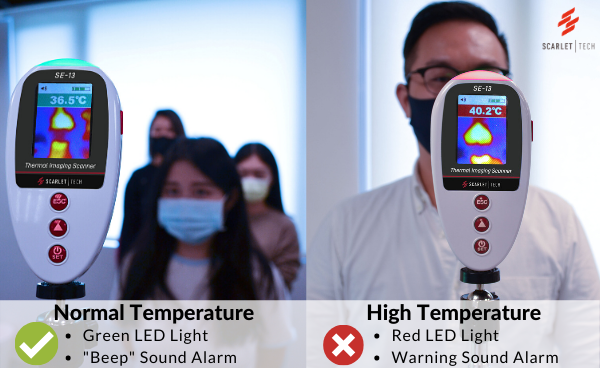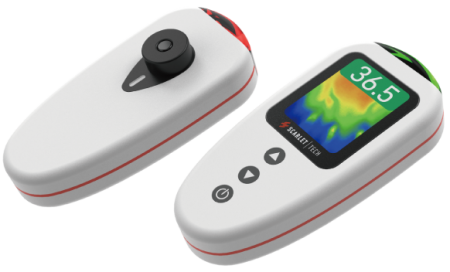Know How –
5 Common Misconception About Thermal Imaging Scanner Answered
- The number of Covid-19 cases worldwide keeps on increasing. As of today, there are more than 40 million cases worldwide. For updated statistics, click here.
- Covid-19 is caused by the SARS-CoV-2 virus, which spreads between people, some countries imposed strict regulations to fever screen people at entrances and comply to the new normal protocol.
- In this article, we share five truths about thermal scanner and how it helps to minimize the spread of Covid-19. Should I get thermal scanner?Find your answer below.
Some of the common misconceptions about thermal imaging scanner are:
1.Does thermal camera detect and treat virus?
No – The role of the thermal camera is to measure someone’s skin temperature. Normal temperature can vary from person to person. But according to NHS (National Health Service), having a body temperature of 38°C (100.4°F) or above is deemed as high fever. Although not all high body temperature is associated with sickness or virus, and not all who is infected with the Covid-19 will show a fever symptom, it is not worth neglecting the fact that still the majority of the people who show a fever symptom are usually more prone to sickness and might be infected with the Covid-19.
Prevention is always better than cure. Thermal scanner is designed to do fever screening which served as an early precaution to help detect the possible covid 19-infected person and therefore minimize the risk of the disease spread.
Along with facemasks and alcohols, the thermal scanner has become one of the in-demand products in the market today. During the SARS outbreak, thermal scanners were recommended to detect the possible SARS-infected person. It was a crucial medical device that helped prevent the spread of SARS.
The same is happening today with the Covid-19 pandemic. The use of thermal scanners is seen effective since it is fast, non-invasive, fairly accurate, and cost-effective. However, some people think that it is also effective in treating people with Covid-19 and could guarantee full protection from the virus.

2.How accurate is thermal camera?
The accuracy of thermal camera can vary among different brands. There are some factors
that influence its accuracy:
- Emissivity
- Reflected ambient temperature
- Transmittance
- Atmosphere temperature
- Camera response
- Calibrator (blackbody) temperature accuracy
Among all those factors, the camera response and blackbody are the two internal factor resulting from the thermal camera itself, while the rest are external factors. The camera response is influenced by the detector’s sensitivity, internal reflections, lens aperture, and the calibration process itself.
Most IR camera data sheets show an accuracy specification such as ±2ºC or 2% of the reading. This results from a widely used uncertainty analysis technique called “Root‐Sum‐of‐Squares”, or RSS.
While blackbody is a device that can regulate temperature very accurately (not all are equal) and have a high emissivity level, which means they are almost not affected by surrounding heat or energy. All thermal cameras are calibrated against blackbodies to give the camera a consistent temperature reference to which it can adjust. Scarlet’s SE 13 has a high accuracy of +/-0.3°C
with enhanced sensitivity detection between 32~42°C which capture temperature differences as small as 0.1°C.

3.Is there any difference between people with darker or lighter skin color?
No – skin color, whether dark or light, has the same temperature transference, emittance, and thickness. In a thermal image, the skin color will not affect the temperature as IR scanner will count the radiated heated body temperature. Unlike typical industrial thermal cameras, SE-13 thermal scanner was developed and calibrated for precise skin temperature measurement and maximizes accuracy by referencing the black body with a known temperature value.
4.Are all thermal cameras suitable for temperature detection?
No- not all thermal camera are created for temperature detection. Historically, a thermal camera is developed for security and defense purpose, which are used to detect threats and give situational awareness, such as “night vision” for British anti-aircraft defense following World War I.
The thermal camera used for temperature detection is a thermometric camera, which will undergo a rigorous calibration together with the lens so it produces accurate temperature reading results.
5.Can the thermal camera be placed outdoors for measuring?
Outdoor environments can be challenging for a thermal camera as it needs a stable environment to control its accuracy, and just like most cameras it might suffer from false measurement when placed outdoor with little control of all the dynamic environmental factors such as sunlight, humidity, rain, turbulence, etc. Most thermal cameras need a stable environment with less interference for best accurate measurement result. Therefore, indoor used is highly preferred.
Does Thermal Camera worth it?
Just like the Dutch philosopher Desiderius Erasmus put it, ‘prevention is better than cure’. Regardless of the finding that some people might be asymptomatic, the best we could do is to put extra effort for prevention.
In some countries, such as Taiwan, Japan, Australia, Singapore, etc., there are regulations for to fever screen people at most public place entrances as they are adapting to the new normal standard. If you are currently using gun thermometer to check people’s temperature every time they come in, this would cause long lines in many places with high traffic. If the checker got sick, the next day they would start putting everyone else they checked at a great risk of getting sick.
According to WHO, Covid-19 spreads between people, mainly when an infected person is in close contact with another person. Current evidence suggests that the main way the virus spreads is by respiratory droplets among people who are in close contact with each other. This is more likely to happen when people are in direct or close contact (less than 1 meter apart) with an infected person.

SE 13 Non-Contact Thermal Scanner

•Measure temperature & detect fever symptoms in real-time
•Non-Contact. Keep a safe distance between visitors and inspectors
•High accuracy+/-0.3°C
•Capture temperature differences as small as 0.1°C
•Adjustable temperature threshold with optional buzzer alert
•Green/Red Light for instant Go/No-Go indicator
Wireless Crane Camera
Why You Need a Wireless Crane Camera System?
Do you know? the major cause of deathly injuries was struck by loads during crane operation, contributing an average of 22% of the total injury, surpassing the number of fatal injury caused by transportation incidents and crane collapses.The most common causes in crane accidents occur in blind lift situations where the operator has limited visibility and therefore is completely dependent to the dogmen, riggers, or signalers to instruct them when moving the loads from one point to another.
Wireless crane camera system is proven to be effective in increasing crane operator job-site awareness by 50%. How wireless crane camera system helps crane operator and businesses?
Heat Stress
What is Heat Stress?
Heat stress is the effect that the thermal environment has on a person’s ability to maintain a normal body temperature. Physical work generates heat in the body which must be lost to the environment through sweating and evaporation. A hot or humid environment makes this more difficult and this can affect both mental and physical performance. Inability to get rid of body heat adequately may result in heat illness.
Workers who are exposed to extreme heat or work in hot environments may be at risk of heat stress. Exposure to extreme heat can result in occupational illnesses and injuries. Heat stress can result in heat stroke, heat exhaustion, heat cramps, or heat rashes.
Other Know Hows
Wireless Crane Camera
Why You Need a Wireless Crane Camera System?
The most common causes in crane accidents occur in blind lift situations where the operator has limited visibility and therefore is completely dependent to the dogmen, riggers, or signalers to instruct them when moving the loads from one point to another. Find out how wireless crane camera system can effectively help in increasing crane operator job-site awareness.
Heat Stress
What is Heat Stress?
Heat stress is the effect that the thermal environment has on a person’s ability to maintain a normal body temperature. Inability to get rid of body heat adequately may result in heat illness.
